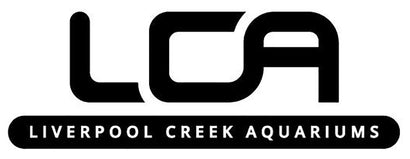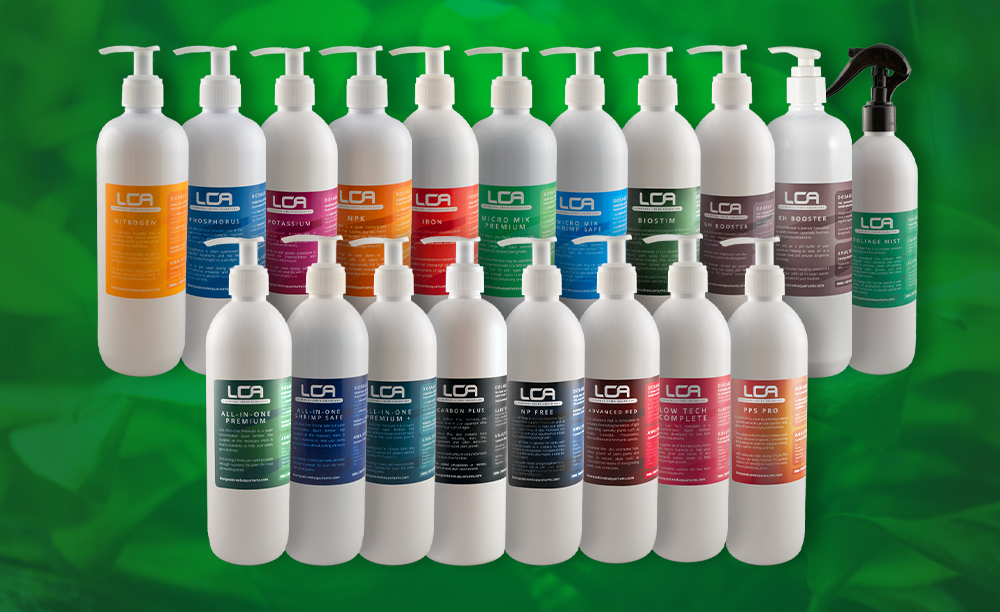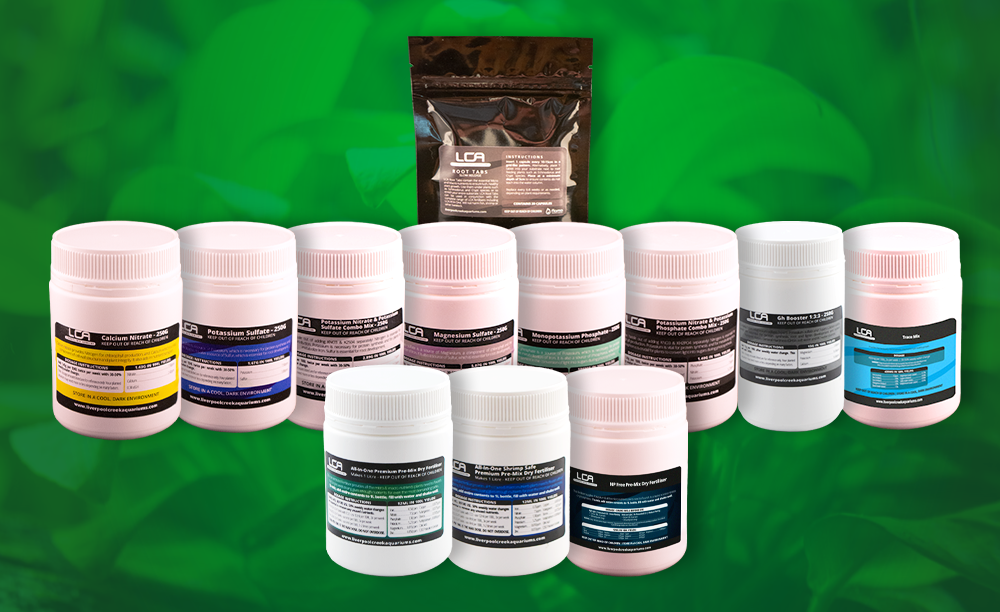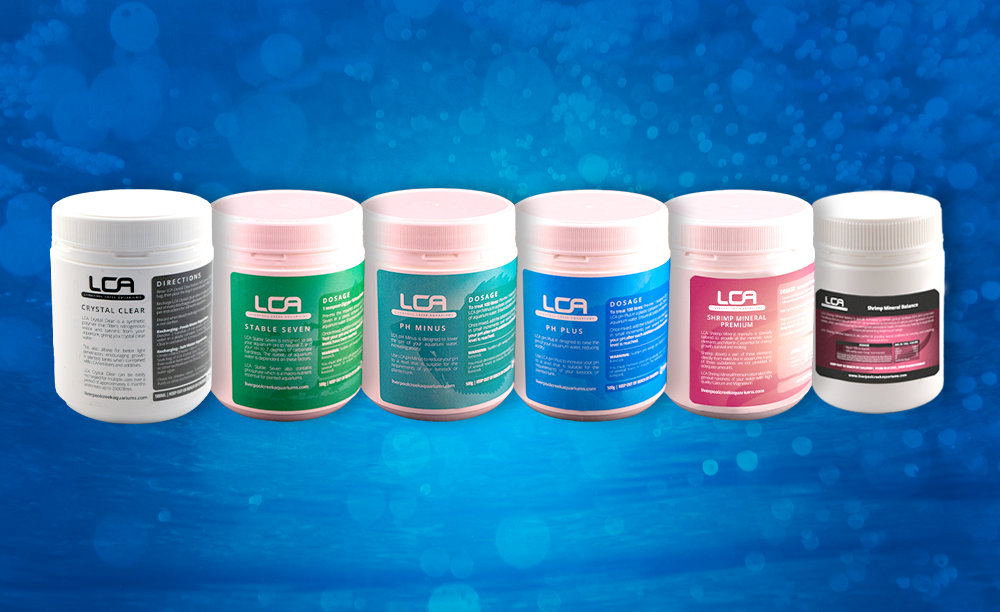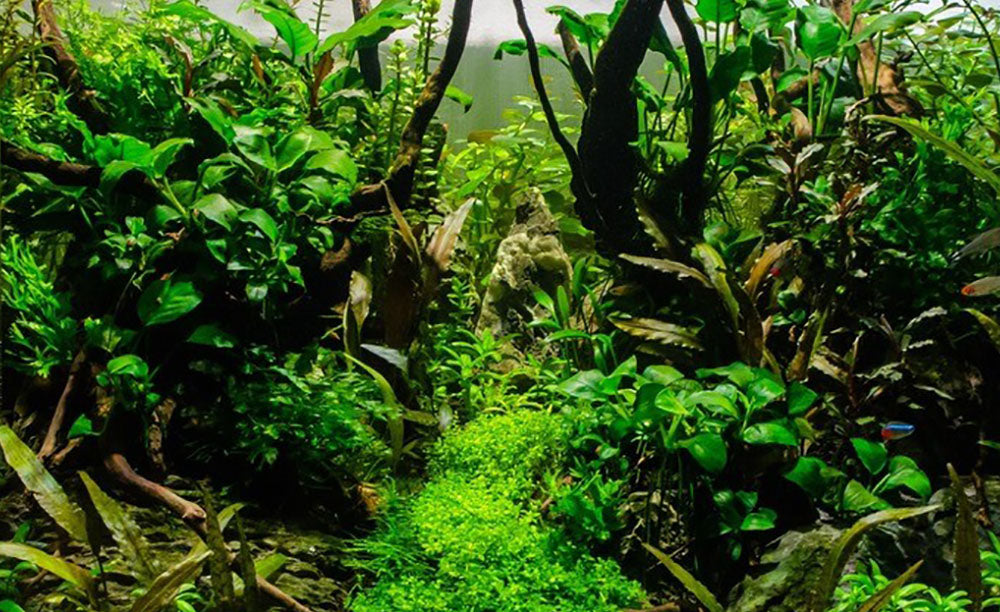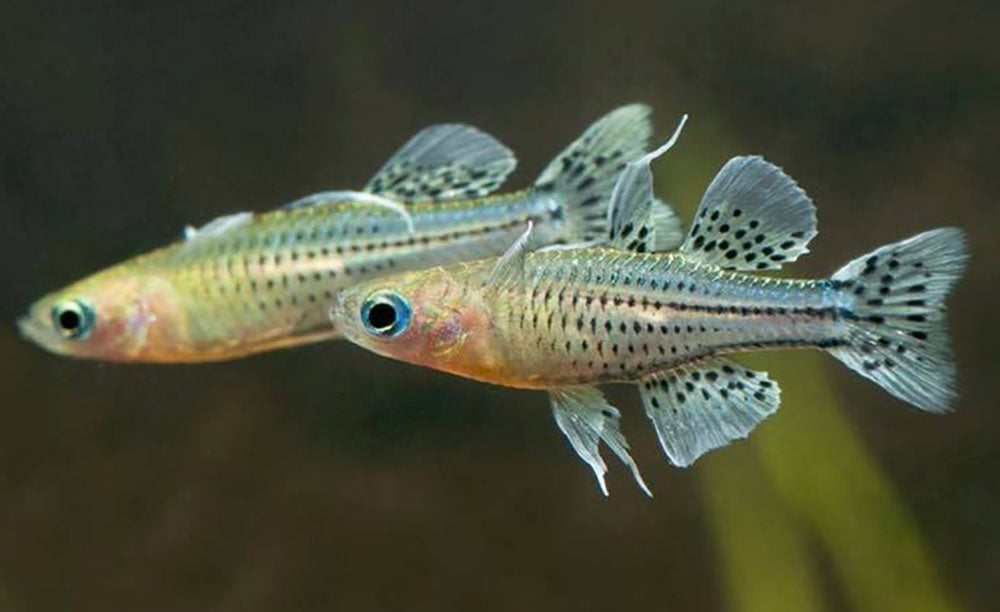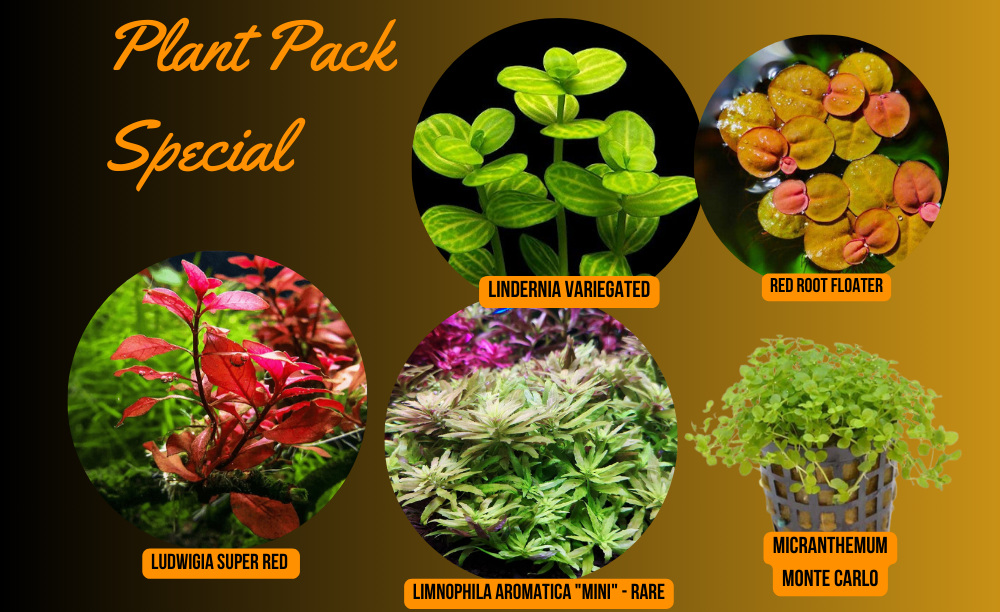Your Cart is Empty
*******FREE SHIPPING FOR ORDERS OVER $200*******
submit your order by 11.59 am Sunday morning for same week delivery
*******FREE SHIPPING FOR ORDERS OVER $200*******
submit your order by 11.59 am Sunday morning for same week delivery
Store
SPECIALS / PLANT PACKS

New To Planted Aquariums
7 min read
Starting a planted aquarium using pressurised CO2 (high-tech)
With pressurised CO2 injection, the right lighting and fertiliser regimen you can achieve an amazing planted aquarium with all sorts of plant species and incredible colours!
Cycling
You can plant your aquarium straight away while starting the process of cycling. Cycling your tank properly ensures you will have healthy biological and mechanical filtration to keep your tank running under optimal conditions. Cycling also helps to reduce algae as the good bacteria converts ammonia algae thrives on into nitrates your plants can use.
Parameters
When deciding on the plants you want for your aquascape , it’s important to take your water parameters and lighting into consideration. With CO2 you can grow a huge variety of plants, but you will be somewhat limited by the PH and hardness of your water as well as the strength of your lighting.
All of the plant descriptions in our store include information to help you decide what plants will work in your aquarium. If you want to grow something that won’t thrive in your current water conditions, adjusting with additives, GH and KH Boostersis always an option!
CO2 injected aquariums need intense lighting to really push plants to their best growth, so make sure you purchase something that can punch down to the full depth of your tank and provide adequate PAR for all those nutrient-hungry plants!
Not sure about what lighting you’ll need?
Fertilising
The easiest and most reliable way to fertilise an aquarium is by using the EI or Estimative Index method. This supplies an excess of nutrients to your plants, so if there’s anything visibly wrong with your plants, you can rule out lack of nutrients as a contributing factor and focus on water parameters, CO2 and lighting.
Several LCA Fertilisers including All in One Premium are dosed using the EI Method and are a perfect choice for CO2 injected aquariums.
For advanced hobbyists, fertilisers such as LCA Advanced Red or Low Tech Complete can be used for High Tech setups at the full dosage rate. Both contain a 100% comprehensive macro & micro formula of N, P, K Iron and trace elements.
All LCA fertilisers are shrimp safe, but if you are keeping particularly delicate ornamental shrimp species, or if you just want peace of mind, LCA All in One Shrimp Safe and Micro Mix Shrimp Safe contain less copper and other elements that shrimp are sensitive to, while still providing all the necessary nutrients for healthy plant growth.
In the first few weeks of starting your planted aquarium, if you’re using a nutritious substrate like aquasoil, or if you have a smaller plant mass, you can dose half the recommended amount of fertiliser. As your plant mass increases and soil begins to deplete, increase your dosage to the recommended amount.
Starting a planted aquarium with NO pressurised CO2 (low-tech)
Low-tech tanks without pressurised CO2 injection can still grow beautiful plants, and the slower growth rate makes them low-maintenance and easy to care for. They don’t require intense lighting and are easy to fertilise. With the right plant choices, you can have a stunning, lush planted aquarium.
Cycling
You can plant your aquarium straight away while starting the process of cycling. Cycling your tank properly ensures you will have healthy biological and mechanical filtration to keep your tank running under optimal conditions. Cycling also helps to reduce algae as the good bacteria converts ammonia algae thrives on into nitrates your plants can use.
Parameters
When deciding on the plants you want for your aquascape , it’s important to take your water parameters and lighting into consideration. Most low-tech plants are generally not fussy, but you will still be somewhat limited by the PH and hardness of your water with some varieties.
If you want to grow something that won’t thrive in your current water conditions, adjusting with additives, GH and KH Boosters are again great options.
Low-tech aquariums don’t need the intense lighting of CO2 injected aquariums as the plants are not going to be as nutrient-hungry or demanding. While a lot of low-tech plants such as anubias and java fern typically grow well under low lighting conditions, other plants will still need medium strength lighting to thrive.
Fertilising
For Low Tech aquariums we have created LCA NP Free and Low Tech Complete. They’re both perfect solutions as they provide a less concentrated amount of nutrients as well as algae-inhibiting additives.
NP Free contains zero nitrate and phosphate, so if you want to keep and breed a number of fish but also have a healthy planted tank it’s ideal for that. The fish will provide the nitrate and phosphate your plants need, and NP Free supplies the rest!
Low Tech Complete provides all the nutrients your plants need including nitrate and phosphate, but in a reduced concentration. It also adds glutaraldehyde which can inhibit or weaken algae as well as provide a boost to plant growth. If you’re looking for an easy way to give your low-tech aquarium everything it needs to grow beautiful, algae-free plants, this is the fertiliser for you!
Of course, you can use any of the LCA fertiliser range including the ever popular All in One Premium, you’ll just need to adjust your dosage rates according to the reduced needs of your low-tech setup. We provide suggested dosage rates for both high-tech and low-tech aquariums on all our product labels.
All LCA fertilisers are shrimp safe, but if you are keeping particularly delicate ornamental shrimp species, or if you just want peace of mind, LCA All in One Shrimp Safe and Micro Mix Shrimp Safe contain less copper and other elements that shrimp are sensitive to, while still providing all the necessary nutrients for healthy plant growth.
In the first few weeks of starting your planted aquarium you should dose half the recommended amount of fertiliser. As your plant mass increases you can increase your dosage to the recommended amount.
Restarting a mature aquarium
There comes a time for every aquarist where you look at your aquarium and decide it’s time for a change! It might be time to try a new aquascape or maybe your plants aren’t thriving and you want to try using CO2. Maybe you’ve had a massive algae outbreak! Whatever the case, it’s important to restart the right way.
Draining
The first step in a restart is to remove your livestock (if you have any) and completely drain your tank. If you have a spare empty aquarium, drain the water into that, pop in your livestock and keep running your filter in the temporary holding tank – you wouldn’t want to lose all that great beneficial bacteria and have to cycle again! If you don’t have a spare aquarium, large storage containers also do the job.
Now the tank has been drained, you can remove all your plants (or algae!), décor (such as driftwood/rocks/sculptures) and your substrate. If your substrate is gravel or sand and you plan to reuse it, make sure you give it a really good wash to remove all the accumulated detritus. If you’re using aquasoil older than 6 months, it’s inert by now and ready to discard.
Décor can be scrubbed to remove algae, or if you don’t mind it – leave it!
If you still have healthy plants, float them in the temporary holding tank. Not only will this keep them alive, it will reduce the stress on your livestock as they can hide amongst the plants. Trim off any unhealthy leaves as these won’t recover.
Plants covered in algae can be dipped to either kill or weaken the algae.
Filling
Great job, the boring part is over! Now you get to set up your aquarium the way you want.
First, put in your substrate, and ensure you have enough depth to support your plants. 6-8cm is a good depth that will support the root systems of any plant species and will stop them from floating out after planting. If you’re using an inert substrate, consider adding Root Tabs to quickly enrich it.
Once your substrate is in, you can add in your décor and plants. It’s a good idea to have a spray bottle filled with aquarium water for this stage. As you continue to add plants to your aquarium, use the spray bottle to keep your plants moist. Consider your water parameters and the lighting you’ll have available to make sure the plant species you’re adding will grow happily in your conditions.
Take into consideration where your filtration intake/output will be and any other equipment such as your heater and CO2 diffuser.
Once you’ve finished planting and decorating, it’s time to refill! Use a mix of the drained water from your holding tank and fresh dechlorinated water. Make sure you fill gently so your substrate isn’t disturbed. One way to do this is to put a clean sponge in the aquarium and direct water onto that, which disperses the water slowly. Another method is to use a garden hose with a shower type spray head attached, using the lowest pressure possible.
Make sure your water parameters and temperature are as close to previous conditions so your livestock won’t be shocked by any sudden changes.
Now the aquarium is full of water, you can set up your filtration and other equipment, then reintroduce your livestock.
The First Few Weeks
For the first few weeks of your newly set up aquarium’s life, your plants are going to be under some stress and won’t be as nutrient hungry while settling in and forming roots.
You might also notice some of your plants “melt” or drop some of their leaves. There can be some algae as well – particularly string/thread algae or GSA. This is all perfectly normal in newly set up aquariums and should resolve in a few weeks as long as you provide adequate filtration, maintenance and fertilisation. It’s all part of your aquarium achieving balance.
If there is excessive algae your lighting hours may need to be reduced.
If you’re using a nutritious substrate like aquasoil, or if you’ve added Root Tabs to your substrate, your plants won’t need much fertilisation at all in these early stages. You can still (and should) dose fertiliser in this time, just at a reduced rate –half or less of the recommended dosage will be sufficient. The same goes for inert substrates.
Once plants start exhibiting new growth and your plant mass increases, slowly increase your dose to the recommended amount. Keep an eye on plant growth and adjust your fertiliser dosage slowly if required. After changing any parameters – lighting, fertiliser, PH, etc – observe for changes over several days (for CO2 tanks) or weeks (for non CO2 tanks) before making any other changes.
Have fun watching your new tank mature and enjoy the journey!
With pressurised CO2 injection, the right lighting and fertiliser regimen you can achieve an amazing planted aquarium with all sorts of plant species and incredible colours!
Cycling
You can plant your aquarium straight away while starting the process of cycling. Cycling your tank properly ensures you will have healthy biological and mechanical filtration to keep your tank running under optimal conditions. Cycling also helps to reduce algae as the good bacteria converts ammonia algae thrives on into nitrates your plants can use.
Parameters
When deciding on the plants you want for your aquascape , it’s important to take your water parameters and lighting into consideration. With CO2 you can grow a huge variety of plants, but you will be somewhat limited by the PH and hardness of your water as well as the strength of your lighting.
All of the plant descriptions in our store include information to help you decide what plants will work in your aquarium. If you want to grow something that won’t thrive in your current water conditions, adjusting with additives, GH and KH Boostersis always an option!
CO2 injected aquariums need intense lighting to really push plants to their best growth, so make sure you purchase something that can punch down to the full depth of your tank and provide adequate PAR for all those nutrient-hungry plants!
Not sure about what lighting you’ll need?
Fertilising
The easiest and most reliable way to fertilise an aquarium is by using the EI or Estimative Index method. This supplies an excess of nutrients to your plants, so if there’s anything visibly wrong with your plants, you can rule out lack of nutrients as a contributing factor and focus on water parameters, CO2 and lighting.
Several LCA Fertilisers including All in One Premium are dosed using the EI Method and are a perfect choice for CO2 injected aquariums.
For advanced hobbyists, fertilisers such as LCA Advanced Red or Low Tech Complete can be used for High Tech setups at the full dosage rate. Both contain a 100% comprehensive macro & micro formula of N, P, K Iron and trace elements.
All LCA fertilisers are shrimp safe, but if you are keeping particularly delicate ornamental shrimp species, or if you just want peace of mind, LCA All in One Shrimp Safe and Micro Mix Shrimp Safe contain less copper and other elements that shrimp are sensitive to, while still providing all the necessary nutrients for healthy plant growth.
In the first few weeks of starting your planted aquarium, if you’re using a nutritious substrate like aquasoil, or if you have a smaller plant mass, you can dose half the recommended amount of fertiliser. As your plant mass increases and soil begins to deplete, increase your dosage to the recommended amount.
Starting a planted aquarium with NO pressurised CO2 (low-tech)
Low-tech tanks without pressurised CO2 injection can still grow beautiful plants, and the slower growth rate makes them low-maintenance and easy to care for. They don’t require intense lighting and are easy to fertilise. With the right plant choices, you can have a stunning, lush planted aquarium.
Cycling
You can plant your aquarium straight away while starting the process of cycling. Cycling your tank properly ensures you will have healthy biological and mechanical filtration to keep your tank running under optimal conditions. Cycling also helps to reduce algae as the good bacteria converts ammonia algae thrives on into nitrates your plants can use.
Parameters
When deciding on the plants you want for your aquascape , it’s important to take your water parameters and lighting into consideration. Most low-tech plants are generally not fussy, but you will still be somewhat limited by the PH and hardness of your water with some varieties.
If you want to grow something that won’t thrive in your current water conditions, adjusting with additives, GH and KH Boosters are again great options.
Low-tech aquariums don’t need the intense lighting of CO2 injected aquariums as the plants are not going to be as nutrient-hungry or demanding. While a lot of low-tech plants such as anubias and java fern typically grow well under low lighting conditions, other plants will still need medium strength lighting to thrive.
Fertilising
For Low Tech aquariums we have created LCA NP Free and Low Tech Complete. They’re both perfect solutions as they provide a less concentrated amount of nutrients as well as algae-inhibiting additives.
NP Free contains zero nitrate and phosphate, so if you want to keep and breed a number of fish but also have a healthy planted tank it’s ideal for that. The fish will provide the nitrate and phosphate your plants need, and NP Free supplies the rest!
Low Tech Complete provides all the nutrients your plants need including nitrate and phosphate, but in a reduced concentration. It also adds glutaraldehyde which can inhibit or weaken algae as well as provide a boost to plant growth. If you’re looking for an easy way to give your low-tech aquarium everything it needs to grow beautiful, algae-free plants, this is the fertiliser for you!
Of course, you can use any of the LCA fertiliser range including the ever popular All in One Premium, you’ll just need to adjust your dosage rates according to the reduced needs of your low-tech setup. We provide suggested dosage rates for both high-tech and low-tech aquariums on all our product labels.
All LCA fertilisers are shrimp safe, but if you are keeping particularly delicate ornamental shrimp species, or if you just want peace of mind, LCA All in One Shrimp Safe and Micro Mix Shrimp Safe contain less copper and other elements that shrimp are sensitive to, while still providing all the necessary nutrients for healthy plant growth.
In the first few weeks of starting your planted aquarium you should dose half the recommended amount of fertiliser. As your plant mass increases you can increase your dosage to the recommended amount.
Restarting a mature aquarium
There comes a time for every aquarist where you look at your aquarium and decide it’s time for a change! It might be time to try a new aquascape or maybe your plants aren’t thriving and you want to try using CO2. Maybe you’ve had a massive algae outbreak! Whatever the case, it’s important to restart the right way.
Draining
The first step in a restart is to remove your livestock (if you have any) and completely drain your tank. If you have a spare empty aquarium, drain the water into that, pop in your livestock and keep running your filter in the temporary holding tank – you wouldn’t want to lose all that great beneficial bacteria and have to cycle again! If you don’t have a spare aquarium, large storage containers also do the job.
Now the tank has been drained, you can remove all your plants (or algae!), décor (such as driftwood/rocks/sculptures) and your substrate. If your substrate is gravel or sand and you plan to reuse it, make sure you give it a really good wash to remove all the accumulated detritus. If you’re using aquasoil older than 6 months, it’s inert by now and ready to discard.
Décor can be scrubbed to remove algae, or if you don’t mind it – leave it!
If you still have healthy plants, float them in the temporary holding tank. Not only will this keep them alive, it will reduce the stress on your livestock as they can hide amongst the plants. Trim off any unhealthy leaves as these won’t recover.
Plants covered in algae can be dipped to either kill or weaken the algae.
Filling
Great job, the boring part is over! Now you get to set up your aquarium the way you want.
First, put in your substrate, and ensure you have enough depth to support your plants. 6-8cm is a good depth that will support the root systems of any plant species and will stop them from floating out after planting. If you’re using an inert substrate, consider adding Root Tabs to quickly enrich it.
Once your substrate is in, you can add in your décor and plants. It’s a good idea to have a spray bottle filled with aquarium water for this stage. As you continue to add plants to your aquarium, use the spray bottle to keep your plants moist. Consider your water parameters and the lighting you’ll have available to make sure the plant species you’re adding will grow happily in your conditions.
Take into consideration where your filtration intake/output will be and any other equipment such as your heater and CO2 diffuser.
Once you’ve finished planting and decorating, it’s time to refill! Use a mix of the drained water from your holding tank and fresh dechlorinated water. Make sure you fill gently so your substrate isn’t disturbed. One way to do this is to put a clean sponge in the aquarium and direct water onto that, which disperses the water slowly. Another method is to use a garden hose with a shower type spray head attached, using the lowest pressure possible.
Make sure your water parameters and temperature are as close to previous conditions so your livestock won’t be shocked by any sudden changes.
Now the aquarium is full of water, you can set up your filtration and other equipment, then reintroduce your livestock.
The First Few Weeks
For the first few weeks of your newly set up aquarium’s life, your plants are going to be under some stress and won’t be as nutrient hungry while settling in and forming roots.
You might also notice some of your plants “melt” or drop some of their leaves. There can be some algae as well – particularly string/thread algae or GSA. This is all perfectly normal in newly set up aquariums and should resolve in a few weeks as long as you provide adequate filtration, maintenance and fertilisation. It’s all part of your aquarium achieving balance.
If there is excessive algae your lighting hours may need to be reduced.
If you’re using a nutritious substrate like aquasoil, or if you’ve added Root Tabs to your substrate, your plants won’t need much fertilisation at all in these early stages. You can still (and should) dose fertiliser in this time, just at a reduced rate –half or less of the recommended dosage will be sufficient. The same goes for inert substrates.
Once plants start exhibiting new growth and your plant mass increases, slowly increase your dose to the recommended amount. Keep an eye on plant growth and adjust your fertiliser dosage slowly if required. After changing any parameters – lighting, fertiliser, PH, etc – observe for changes over several days (for CO2 tanks) or weeks (for non CO2 tanks) before making any other changes.
Have fun watching your new tank mature and enjoy the journey!
Subscribe
Sign up to get the latest on sales, new releases and more …
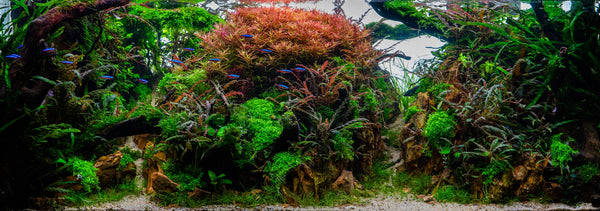
Join Us
Join our Facebook group and benefit from the knowledge of
Australia’s largest community of planted aquarium enthusiasts!
